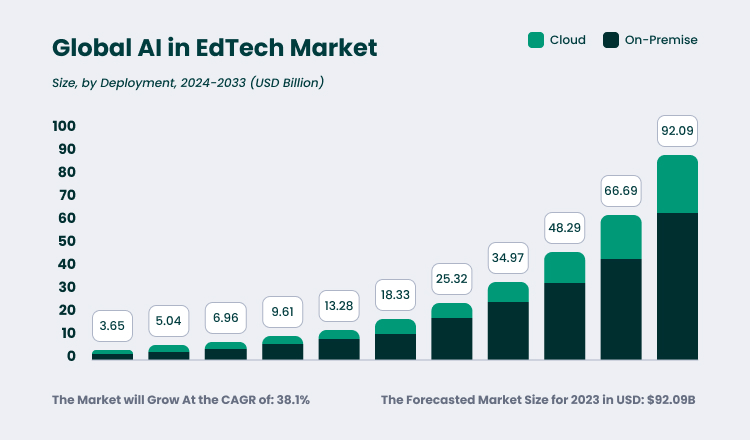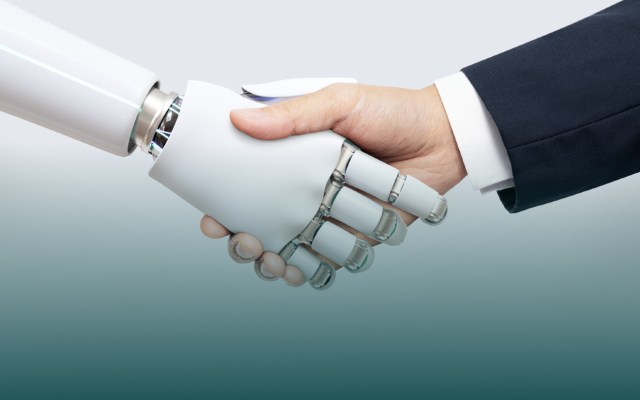“Traditional teaching is something that is given to you. Personalized learning is something you seek,” says Catrin Lingad. This is crucial to remember if you’re planning to provide educational services. Whether you’re a startup or an experienced player, you can’t stay aside of cutting-edge technologies.

If you’re still skeptical about any change, consider these points. Traditional education methods often fail to meet the diverse needs and demands of learners. Plus, they can also make education boring and not fruitful. As a result, learning and teaching are becoming less effective.
In large classes, students often don’t receive the individual attention they need. A one-size-fits-all approach only works for some, leading to boredom and low motivation. Teachers also face many challenges, including heavy administrative workloads, outdated materials, and difficulties in maintaining students’ attention. Should we continue down this path?
With AI in your toolkit, you can tackle these problems. AI education can personalize learning, adjusting to each student’s pace and style and providing them with the support they need. AI can also take over routine administrative tasks, giving teachers more time to focus on teaching. Plus, AI tools can offer up-to-date resources and help ensure that students in remote areas have access to quality education.
What AI education solutions can transform your EdTech business, and what kind of learning will you offer your clients? Keep learning Forbytes’ post to understand how you can apply artificial intelligence and shift from traditional approaches.
Rise of AI in 4.0 Education: Let’s Look at the Numbers
Artificial Intelligence is transforming EdTech by making learning more personalized and efficient. AI tools, like machine learning and data analytics, help tailor educational experiences to individual needs and streamline processes. The growing demand for AI education reflects the evolution of learning and the emergence of new methods and techniques.
According to the latest report, the size of the global AI in the EdTech market is expected to reach around $92,09 billion by 2033, up from $3,65 billion in 2023, with an annual growth rate of 38,1% from 2024 to 2033.
The AI in the EdTech market is booming as schools and tech companies recognize that AI changes education. Major players include both big EdTech companies and startups, all of which are investing in AI education, developing new tools, and partnering with schools. So, we can confidently say that artificial intelligence won’t destroy the education system. On the contrary, it will fuel it with new technologies and boost its quality and efficacy.
According to Forbes Advisor’s survey, teachers have mixed feelings about AI in education.
55% of respondents believe that AI education helps improve learning while 18% think it might hinder educational outcomes. 17% feel it doesn’t make much difference, and 10% are unsure of AI’s impact. This shows that while many see AI as beneficial, there are still concerns and uncertainties about it, which we aim to address.
Why Such a Rapid Growth? Benefits of AI in Education
Many EdTech unicorns, such as Khan Academy, Duolingo, and Coursera, invest heavily in AI to enhance personalized learning experiences. This is a sign that AI is not just a trend but a powerful tool that works for businesses and their audiences. So, why neglect AI education?
But before adopting AI-powered EdTech solutions, it’s necessary to understand what this EdTech trend can bring to the table.
Personalized learning
AI education personalizes learning by tailoring methods and techniques to each learner’s needs. How does it work? AI analyzes large volumes of data to identify and understand students’ learning patterns, strengths, and weaknesses. The insights gained from this analysis help pick a personalized learning approach for each student.
For instance, AI-powered platforms like Smart Sparrow and DreamBox use adaptive learning technology to design lessons based on real-time student performance. This allows learners to choose their difficulty level and progress at their own pace.
Better access to education
AI for education supports diverse students, including those with disabilities. As a result, this makes learning more accessible. Tools like predictive text, text-to-speech, and speech-to-text assist students with vision, hearing, and learning impairments.
For example, Microsoft’s Seeing AI app uses artificial intelligence to help visually impaired students recognize faces, read text aloud, and describe their surroundings. This enables students to move around with more confidence and independence. The app helps them become more active and engaged in their learning by providing the necessary tools.
Automation of routine teachers’ tasks
Teachers have so many administrative tasks that they have less time and space for creative techniques. Scheduling, lesson planning, and grading belong to the routine that requires much effort. AI in schools can solve this dilemma by automating repeated tasks and saving time for teaching.
For instance, AI-powered tools like Turnitin and GradeScope can help with detecting plagiarism and grading assignments, allowing teachers to provide constructive feedback.
More engagement and interactivity
AI for learning makes the educational process more engaging and interactive. Tools like simulations, personalized quizzes, and adaptive platforms adjust to each student’s learning style. AI-powered chatbots and virtual tutors provide instant feedback, keeping students motivated. This makes learning more enjoyable and helps students better understand and retain information.
For example, IBM’s Watson Tutor is a virtual assistant that provides instant feedback and support, helping learners stay motivated and engaged. Kahoot! and Quizlet are gamified AI-based learning platforms that can personalize games and quizzes and make learning interactive and fun.
So see, the rapid growth of AI education is the outcome of its benefits that transform learning by making it more personalized and accessible. We hope that they have persuaded you that AI for learning is worth trying if you want to breathe new life into education and make it more advanced and innovative.
Looking to fuel your business with AI education solutions? Contact Forbytes, and we’ll help you get started!
Top 6 Use Cases of Artificial Intelligence in Education
Since you’re aware of the benefits of AI education, it’s high time to explore how artificial intelligence can transform your business and where you can apply it. Here are some examples of artificial intelligence in education:
- Tailored learning journeys: Using machine learning and data analytics, you can customize educational content to fit each student’s proficiency and learning style. For instance, DreamBox Learning offers math lessons that adjust in real-time based on a student’s progress.
- Virtual learning assistance: AI chatbots can answer student questions in online courses. For example, Georgia Tech’s “Jill Watson” helps students, making online learning more engaging and supportive.
- Automated grading: AI and machine learning can be used to quickly grade multiple-choice and short-answer questions. For example, Gradescope by Turnitin reduces instructors’ workload and speeds up feedback for students.
- Intelligent tutoring: With machine learning and natural language processing, you can provide personalized tutoring. For example, Carnegie Learning’s MATHia offers real-time feedback and hints to help students solve problems and improve their understanding.
- Content generation: You can use natural language generation and machine learning to create quiz questions and learning materials. For example, Quillionz helps by turning text into content, making it easier for teachers to prepare materials and focus on teaching.
- Adaptive assessments: With machine learning, you can adjust test difficulty based on responses. For example, Duolingo’s tests modify difficulty based on answers to measure language skills and personalize learning.
Embracing these AI-driven approaches can transform your educational practices, making learning more effective and engaging. But how to integrate AI into your EdTech business? Here are some simple steps to follow.
How Forbytes Approaches AI Integration in Education
AI integration in education can be challenging if you don’t follow the essential steps needed to achieve your desired outcome. We’ve prepared a detailed roadmap to help you with AI implementation:
Step 1: Start with setting clear goals
When considering AI integration into your EdTech business, it’s tempting to start by selecting technologies and tools. Instead, begin by defining what you want to achieve with AI. What bottlenecks do you want to solve? What gaps do you need to spot? Determine how AI can improve learning experiences or streamline administrative tasks.
Step 2: Pick the right tools
The next step is to select the right AI technologies and tools that align with your educational goals. For this, you’ll need to consider AI capabilities such as machine learning, natural language processing, and adaptive learning systems. Evaluate the pros and cons of each tool and ensure they align with your goals.
Step 3: Follow established standards
Review EdTech standards like xAPI, SCORM, and AICC to ensure your platform can share data and track learner progress. Keep up with new standards to remain compliant, ensure your technology integrates well with other systems, and adapts to changes.
Step 4: Build or customize an AI-powered solution
When integrating AI into EdTech, you have two main options: using an off-the-shelf tool or building a custom AI solution. That’s why evaluate the pros and cons of each option to determine what will work best for your company and align with your educational goals.
Step 5: Test your AI system
Thoroughly test AI systems to ensure they function as intended. Collect feedback from users to identify issues and make improvements. Continuously refine and monitor AI tools to maintain performance. Update documentation and provide training for your team as needed.
Step 6: Monitor the AI integration
Continuously track the performance of your AI system to ensure it meets educational goals. Use data and user feedback to assess effectiveness and make improvements. Keep detailed records and hold regular review sessions to optimize the AI system.
By following these steps and staying informed about EdTech standards, Forbytes ensures effective and compliant AI integrations in education.
Tips from Forbytes for Achieving Success with AI in Education
As we build on the lessons learned, it’s clear that new developments in AI may provide much-needed innovation in education. To make sure that AI enhances Education 4.0 and lifelong learning, we need to deploy them strategically and safely, taking into account the following factors:
First, make sure AI education tackles existing gaps by focusing on fairness. This means addressing gender, and school type, and supporting diverse abilities and learning styles while removing language and access barriers.
Second, AI won’t replace human teachers. Instead, it should help by automating routine tasks and giving teachers more time to focus on teaching. AI can also offer training to help teachers use AI effectively in their lessons.
Finally, along with using AI tools in education, it’s important to teach students about AI itself. This means focusing on AI skills, understanding its risks, and preparing students to create and use AI responsibly in the future.
At Forbytes, we implement the best online education practices and methods in the digital solution and fuel your education software with AI. Our educational software development services can transform your EdTech business.
Need help integrating AI into your education software? Contact us for expert assistance and support.













